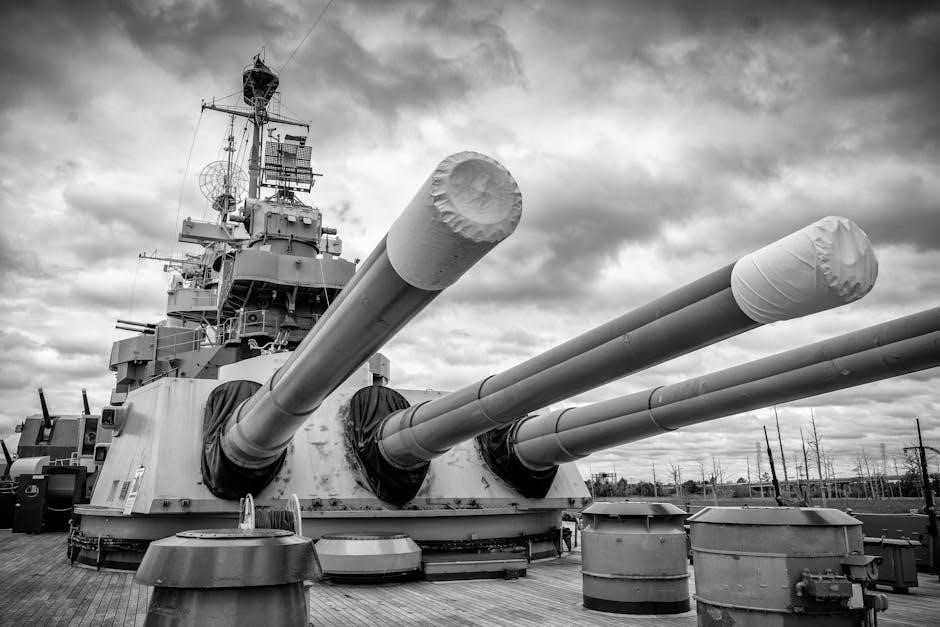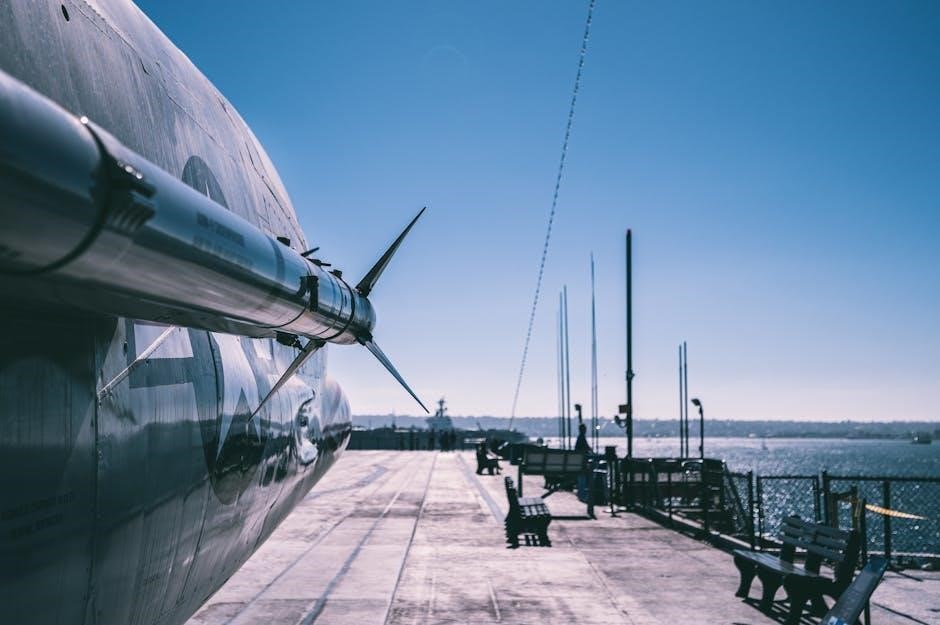The USS Hopper (DDG-70) is an Arleigh Burke-class guided missile destroyer, named after Rear Admiral Grace Hopper, a pioneer in computer science and naval history. Based in Pearl Harbor, it serves as a key asset in the Pacific Fleet, showcasing advanced technology and operational versatility.

1.1 Overview of the USS Hopper (DDG-70)
The USS Hopper (DDG-70) is an Arleigh Burke-class guided missile destroyer, homeported in Pearl Harbor, Hawaii. Commissioned in 1997, it is named after Rear Admiral Grace Hopper, a pioneering computer scientist. The ship is equipped with advanced systems, including the Aegis Combat System, making it a versatile platform for multi-mission operations. Its design emphasizes survivability, maneuverability, and state-of-the-art weaponry, ensuring it remains a critical asset in global maritime security. The USS Hopper symbolizes both technological advancement and the legacy of its namesake, embodying the Navy’s commitment to innovation and excellence.
1.2 Historical Significance and Naming
The USS Hopper (DDG-70) is named after Rear Admiral Grace Hopper, a trailblazer in computer science and naval service. Known as the “First Lady of Computing,” she developed the first compiler and championed early computer technologies. The ship honors her groundbreaking contributions to the Navy and technology. Its name reflects her pioneering spirit, while its operations continue her legacy of innovation and leadership. The USS Hopper stands as a testament to her enduring impact on both the Navy and the field of computer science, inspiring future generations of sailors and technologists alike.

Design and Capabilities
The USS Hopper (DDG-70) is a Flight I Arleigh Burke-class destroyer, featuring advanced propulsion, Aegis combat systems, and robust armament, including missiles and guns, ensuring superior combat readiness.
2.1 Arleigh Burke-Class Guided Missile Destroyer
The USS Hopper (DDG-70) belongs to the Arleigh Burke-class, the most advanced destroyers in the U.S. Navy. Known for their versatility, these ships are designed for multi-role operations, combining offensive and defensive capabilities. The Arleigh Burke-class is equipped with the Aegis Combat System, providing unparalleled air defense and anti-submarine warfare capabilities. The class is powered by four General Electric LM2500 gas turbines, enabling speeds exceeding 30 knots. With a displacement of over 8,000 tons, these destroyers are built for endurance and adaptability, making them a cornerstone of U.S. naval superiority.
2.2 Advanced Propulsion and Maneuverability
The USS Hopper (DDG-70) is powered by four General Electric LM2500 gas turbines, delivering over 100,000 horsepower. This advanced propulsion system enables the destroyer to achieve speeds exceeding 30 knots, ensuring exceptional maneuverability and responsiveness. The ship’s design emphasizes stability and seakeeping, allowing it to operate effectively in diverse maritime environments. The combination of power and precision engineering makes the USS Hopper highly capable of executing its multi-mission roles, from rapid deployment to sustained operations at sea, further solidifying its role as a critical asset in naval operations.
2.3 Armament and Defensive Systems
The USS Hopper (DDG-70) is equipped with a MK 45 5-inch gun for surface warfare and Tomahawk land-attack missiles. Its defensive systems include two Phalanx CIWS (Close-In Weapon Systems) for anti-missile and anti-aircraft defense. The ship also features 90 Vertical Launch System (VLS) cells, capable of firing SM-2, SM-3, and Tomahawk missiles. Additionally, it carries Harpoon missiles for anti-ship strikes. This multi-layered armament ensures the USS Hopper can engage threats across various domains, from air and surface to land, making it a versatile and formidable naval asset in modern combat scenarios.
2.4 Aegis Combat System and Electronic Warfare
The USS Hopper (DDG-70) utilizes the advanced Aegis Combat System, providing unparalleled air defense and anti-missile capabilities. This system integrates radar, fire control, and missile systems, enabling the ship to detect and engage multiple threats simultaneously. Enhanced by electronic warfare tools, the Aegis system ensures superior situational awareness and countermeasure deployment. This technology allows the USS Hopper to dominate the battlespace, protecting itself and allied forces from sophisticated adversaries, making it a cornerstone of U.S. Navy’s defense strategy in contested maritime environments.
Operational History
The USS Hopper (DDG-70) has engaged in numerous operations, including joint exercises and maritime interdiction missions. It has demonstrated exceptional capabilities in multi-role deployments, enhancing global security efforts.
3.1 Commissioning and Initial Deployment
The USS Hopper (DDG-70) was commissioned in 1998 after being constructed by Bath Iron Works between 1995 and 1997. Its initial deployment showcased its multi-mission capabilities, operating in the Pacific, Caribbean, and Atlantic. The destroyer participated in NATO exercises in the Mediterranean, demonstrating its role in missile defense and anti-submarine warfare. Early missions highlighted the crew’s readiness and the ship’s advanced systems, establishing it as a vital asset for naval operations. These initial deployments laid the groundwork for its future contributions to global maritime security.
3.2 Notable Missions and Engagements
The USS Hopper (DDG-70) has participated in numerous high-profile operations, showcasing its strategic versatility. It played a key role in maritime interdiction and counter-piracy missions in the Gulf of Aden. In 2024, the destroyer conducted a live-fire exercise in the South China Sea, demonstrating its combat readiness. Additionally, it supported joint exercises with allied navies, enhancing international cooperation. These missions highlight the ship’s ability to adapt to diverse operational demands, solidifying its role as a critical asset in maintaining global maritime stability and security.
3.3 Participation in Joint Military Exercises
The USS Hopper (DDG-70) has actively engaged in multiple joint military exercises, strengthening international partnerships and operational readiness. Notably, it participated in Rim of the Pacific (RIMPAC), the world’s largest maritime exercise, and operated alongside allied navies in the South China Sea. These exercises enhance interoperability, test advanced combat systems, and demonstrate the ship’s capabilities in multi-national scenarios. By collaborating with global forces, the USS Hopper underscores its role as a versatile and reliable asset in fostering regional stability and cooperation, while showcasing the U.S. Navy’s commitment to collective security initiatives worldwide.

Home Port and Crew
The USS Hopper (DDG-70) is stationed at Pearl Harbor, Hawaii, serving as part of the Pacific Fleet’s 31st Destroyer Squadron. The crew consists of approximately 300 sailors, including officers and enlisted personnel, who undergo rigorous training to operate and maintain the ship’s advanced systems, ensuring readiness for multi-mission operations.
4.1 Pearl Harbor as the Home Port
Pearl Harbor, Hawaii, serves as the home port for the USS Hopper (DDG-70), strategically positioning it for operations in the Indo-Pacific region. As part of the Pacific Fleet’s 31st Destroyer Squadron, the ship benefits from Hawaii’s proximity to critical maritime routes. The port provides access to advanced training areas, maintenance facilities, and logistical support, ensuring the destroyer remains operational and ready for deployment. Pearl Harbor’s historic significance also underscores the vessel’s role in upholding maritime security and stability in the region.
4.2 Crew Composition and Training
The USS Hopper (DDG-70) is manned by a highly trained crew of officers and enlisted sailors, with a mix of experienced personnel and new recruits. The crew undergoes rigorous training programs to ensure operational readiness, focusing on combat systems, engineering, and navigation. Regular drills and simulations prepare the team for various scenarios, from anti-submarine warfare to ballistic missile defense. The ship’s crew also participates in joint exercises to enhance coordination with other naval units. Continuous professional development ensures the crew remains proficient in advanced technologies and tactics, maintaining the destroyer’s effectiveness in global operations.

Strategic Role and Mission
The USS Hopper (DDG-70) serves as a multi-mission destroyer, contributing to global maritime security and peace. It operates primarily in the Pacific, supporting regional stability and freedom of navigation. Equipped with advanced systems like the Aegis Combat System, the destroyer excels in anti-submarine, anti-air, and surface warfare. Its strategic role includes protecting critical sea lanes, deterring aggression, and supporting joint military operations. The ship’s versatility enables it to adapt to evolving threats, ensuring readiness to defend national interests and maintain global security through continuous modernization and operational excellence.
5.1 Multi-Mission Capabilities
The USS Hopper (DDG-70) is a versatile warfighting platform designed to execute a wide range of missions. Equipped with the Aegis Combat System, it excels in anti-submarine, anti-air, and surface warfare. The destroyer is capable of engaging multiple threats simultaneously, leveraging advanced radar and missile systems. Its armament includes Harpoon missiles, Tomahawk land-attack missiles, and a 5-inch gun, enabling it to project power ashore and at sea. Additionally, the ship supports maritime interdiction, humanitarian assistance, and joint operations with coalition forces. Its multi-mission design ensures it remains a critical asset for maintaining global maritime security and stability.
5.2 Contribution to Global Maritime Security
The USS Hopper (DDG-70) plays a pivotal role in maintaining global maritime security by safeguarding sea lanes and deterring aggression. Its advanced Aegis Combat System and missile capabilities enable it to protect allied forces and international shipping. The destroyer actively participates in joint military exercises, fostering multinational cooperation and strengthening regional stability. By conducting routine patrols and maritime interdiction operations, the USS Hopper upholds the free flow of commerce and defends against emerging threats. Its presence in critical regions underscores the U.S. Navy’s commitment to a secure and stable global maritime environment.
Current Status and Recent Activities
The USS Hopper (DDG-70) remains operational, conducting recent deployments and exercises, ensuring readiness through continuous maintenance and training, supporting global maritime security operations actively.
6.1 Recent Deployments and Operations

The USS Hopper (DDG-70) has recently concluded a significant deployment, sailing over 41,000 nautical miles. It participated in a live-fire exercise in the South China Sea, demonstrating its combat readiness. The ship also served as the flagship for a Maritime Interdiction Operation, showcasing its multi-mission capabilities. Crew members performed critical maintenance on shipboard weapons systems, ensuring peak operational efficiency. These activities highlight the destroyer’s role in maintaining global maritime security and its commitment to joint military exercises, underscoring its importance in the Pacific Fleet’s operations.
6.2 Modernization and Maintenance Efforts
The USS Hopper (DDG-70) undergoes regular maintenance to ensure operational readiness. Recent efforts included a dry-dock period for hull repairs and painting. Upgrades to its combat systems and electronics were also performed. The ship’s gas turbines received routine servicing to maintain peak performance. Crew members conducted extensive maintenance on weapons systems, ensuring reliability. These efforts aim to sustain the destroyer’s advanced capabilities and readiness for global operations, reflecting the Navy’s commitment to modernizing its fleet and ensuring maritime security. The Hopper’s maintenance ensures it remains a formidable asset in the Pacific Fleet.
Cultural and Historical Legacy
The USS Hopper (DDG-70) honors Rear Admiral Grace Hopper, a trailblazer in computer science. Its insignia features a lion symbolizing strength and courage, reflecting her “Dare and Do” motto, embodying innovation and naval heritage.
7.1 The Legacy of Rear Admiral Grace Hopper
Rear Admiral Grace Hopper was a pioneering computer scientist and naval officer whose groundbreaking work laid the foundation for modern computing. Known as the “Queen of Code,” she developed the first compiler and popularized the term “bug” in programming. Her contributions to the U.S. Navy included advancing computer technology, earning her the nickname “Amazing Grace.” The USS Hopper (DDG-70) honors her legacy, embodying the spirit of innovation and determination she exemplified. Her story inspires future generations, bridging the gap between her trailblazing achievements and the ship’s role in modern maritime security.
7.2 Symbolism in the Ship’s Insignia

The USS Hopper’s insignia features a rampant lion, symbolizing strength, courage, and survivability, aligning with the ship’s motto, “Dare and Do.” The lion, adapted from Scotland’s arms, honors Rear Admiral Grace Hopper’s heritage. The shield embodies her pioneering spirit, blending elements of computer technology and naval tradition, while the waves represent maritime excellence. The insignia’s design reflects the ship’s commitment to innovation and resilience, mirroring Grace Hopper’s groundbreaking contributions to computing and the Navy, ensuring her legacy endures through the vessel’s service and achievements.



